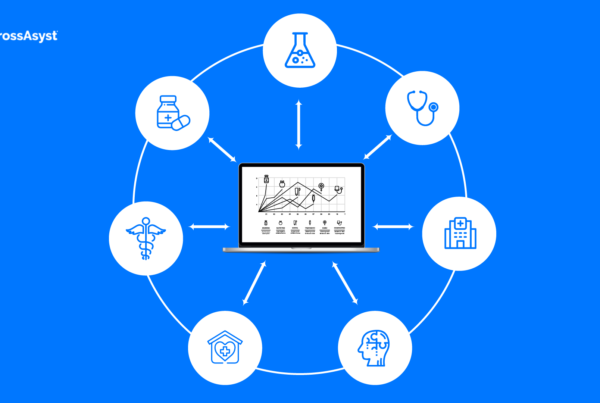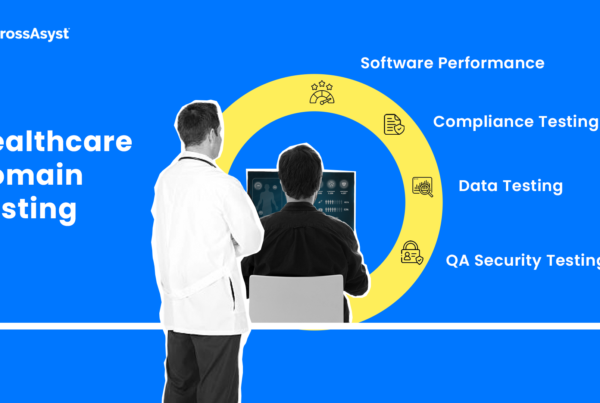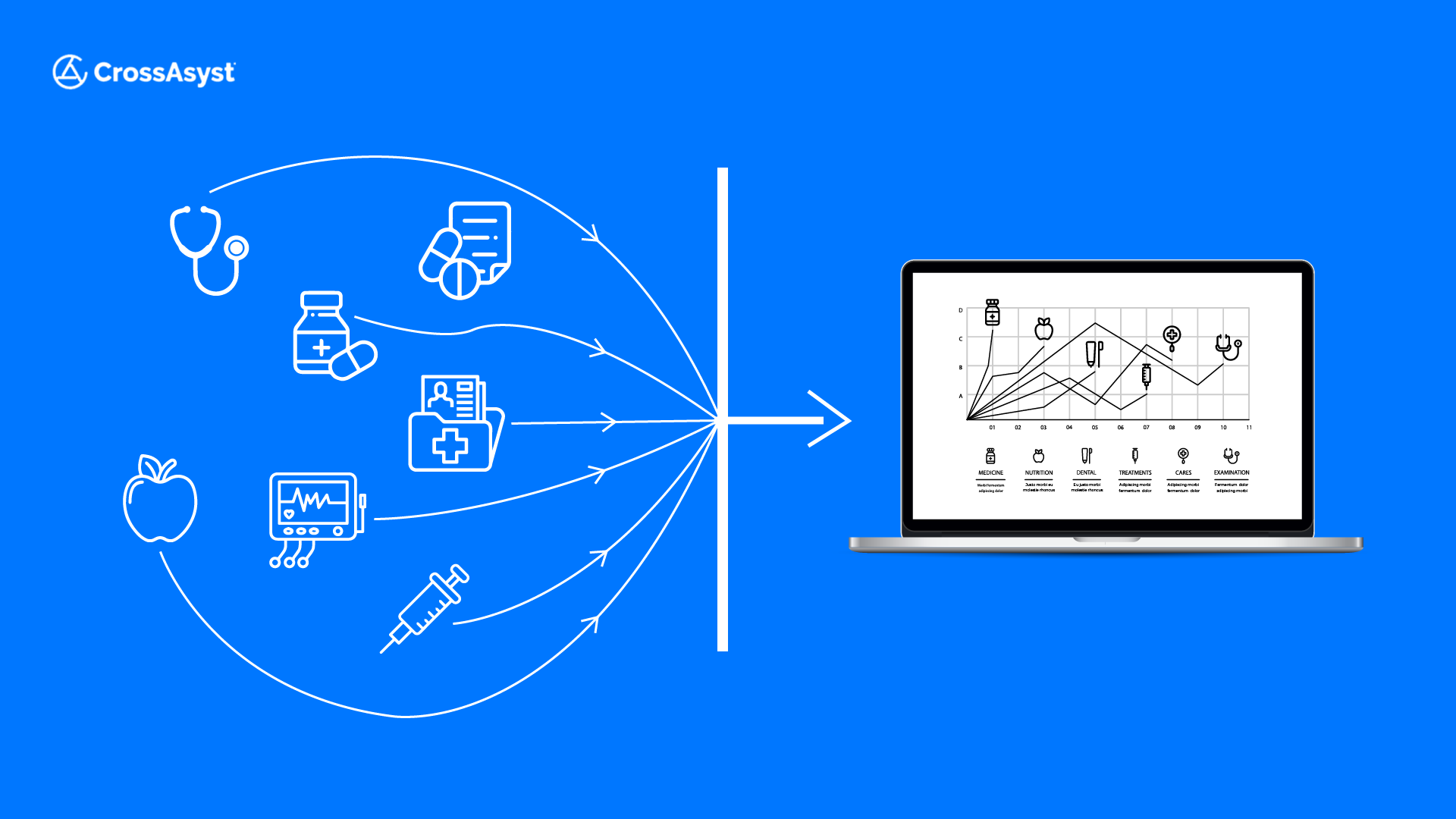
The global Covid-19 pandemic brought to focus how important a role technology plays in healthcare. Remote monitoring, maintenance of digital records, online consultations and more become necessities rather than innovations.
This increased dependence on technology saw the digital healthcare market earn a valuation of around $262.3 billion in 2022, and with a CAGR of 13.1%, it is estimated to grow to an estimated $939.54 billion over the next decade.
Here’s a detailed look at the areas of healthcare that are bound to be affected the most by this digital transformation, its impact on the healthcare industry and more.
Table of Contents
What is Digital Transformation in the Healthcare Industry?
Digital transformation in healthcare means using technology to make healthcare better for patients and doctors. Real digital transformation is when we create new things like health apps that track your health, or secure websites where you can talk to your doctor online. Health apps, video calls with doctors (telehealth), and online medical records are examples of how digital transformation is changing healthcare. These changes bring automatic services, faster medical help, and using computers to learn more about medical information. This makes healthcare easier and better for everyone.
5 Top Key Technologies Driving Healthcare Digital Transformation
Let’s begin by taking a look at the key technologies currently driving this digital transformation in healthcare organizations.
-
Electronic Health Records (EHR)
Electronic Health Records, or EHR, have become the cornerstone of modern healthcare. These digital records contain comprehensive patient information, including medical history, diagnoses, medications, allergies, and test results, all accessible to authorized healthcare providers in real-time.
EHR systems have replaced the traditional paper-based records, significantly improving the efficiency of healthcare delivery, reducing medical errors, and enabling seamless collaboration among healthcare professionals.
-
Telemedicine and Virtual Care Reality

Telemedicine and virtual care have emerged as crucial technologies, especially during times of crisis and in remote areas with limited access to healthcare facilities. Through telemedicine, patients can connect with healthcare professionals via video conferencing, allowing for remote diagnosis, treatment, and monitoring of medical conditions.
Virtual care reality includes virtual reality (VR) and augmented reality (AR) applications, enabling medical professionals to perform simulations, training, and even surgical procedures, enhancing the overall quality of care.
-
Internet of Things (IoT) in Medical Devices
The Internet of Things (IoT) has found its way into medical devices, facilitating the collection of real-time patient data for continuous monitoring and analysis.
IoT-enabled devices, such as wearable health trackers and remote monitoring equipment, provide healthcare professionals with valuable insights into a patient’s health status and can help in early detection of potential health issues.
This technology has significantly contributed to improving patient outcomes and promoting preventive healthcare practices.
-
Artificial Intelligence (AI) and Machine Learning (ML)
Artificial Intelligence and Machine Learning have had a profound impact on healthcare, revolutionizing diagnostic accuracy, treatment planning, and drug development. AI algorithms can analyze vast amounts of medical data, including images, patient records, and research papers, to identify patterns and make data-driven predictions.
Machine learning models assist in diagnosing diseases, predicting patient risks, and personalizing treatment plans, ultimately leading to more effective and personalized healthcare solutions.
-
Big Data and Analytics
The healthcare industry generates an enormous amount of data daily, and leveraging this data efficiently is crucial for improving patient care and operational efficiency.
Big data and analytics technologies help healthcare providers gain valuable insights from this data, aiding in identifying trends, optimizing workflows, and making informed decisions.
From population health management to disease surveillance and patient engagement, Big Data analytics is transforming healthcare in multifaceted ways.
5 Benefits of Digital Transformation in Healthcare
Digitization and the use of technology have made healthcare a lot more precise and efficient in multiple areas, including administrative processes, diagnosis and patient care. Here’s a more detailed look at the positive impact of healthcare digital transformation.
1. Streamlining Administrative Processes
Let’s begin with how digital transformation has made administrative processes more streamlined.
- Utilizing Electronic Health Records (EHRs) for Seamless Data Management
The adoption of Electronic Health Records (EHRs) has significantly improved data management in healthcare facilities. EHRs allow healthcare professionals to access patient information, medical histories, and test results with just a few clicks.
This streamlined approach eliminates the need for paper-based records, reducing the risk of errors and making information readily available to authorized personnel.
-
Automating Appointment Scheduling and Patient Registration
Digital tools have transformed the way patients schedule appointments and register for healthcare services. Automated systems enable patients to book appointments online, enhancing convenience and reducing wait times.
Additionally, streamlined patient registration processes eliminate redundant paperwork, leading to a smoother experience for both patients and healthcare providers.
-
Enhancing Billing and Insurance Claim Processing through Digital Solutions
Healthcare digitization has improved billing and insurance claim processing, making it more accurate and efficient. Automated billing systems help reduce billing errors, ensuring that patients are charged correctly for services rendered.
Similarly, digital solutions facilitate the submission and processing of insurance claims, speeding up reimbursement and reducing administrative burdens.
2. Improved Diagnosis via Machine Learning Algorithms
Advancements in machine learning algorithms have empowered healthcare professionals with powerful diagnostic tools. By analyzing vast amounts of patient data, these algorithms can identify patterns and trends that may not be immediately apparent to human practitioners.
This leads to earlier and more accurate diagnoses, potentially saving lives and improving treatment outcomes.
3. Enhancing Clinical Workflows
Here’s how advancements in technology have enhanced different clinical workflows.
-
Increased Access to Medical Care
Telemedicine and virtual care have emerged as game-changers in healthcare delivery. With these digital solutions, patients in remote or inaccessible areas can access medical consultations without the need for physical travel.
Healthcare providers can remotely diagnose and treat patients, increasing access to quality healthcare and reducing the strain on healthcare facilities.
-
More Accurate and Efficient Diagnosis as well as Treatment Planning
Digitization has brought forth a wide array of sophisticated diagnostic tools and medical imaging technologies. From advanced imaging machines to computer-assisted diagnosis software, these tools aid healthcare professionals in accurately identifying and understanding medical conditions.
Furthermore, digital platforms enable multidisciplinary collaboration among specialists, resulting in more comprehensive treatment plans.
-
Improving Medication Management and Prescription Processes
Healthcare digitization has led to improved medication management and prescription processes. Electronic prescribing systems help prevent medication errors and potential adverse drug interactions.
Additionally, automated medication reminders and tracking tools promote better patient adherence to treatment plans, enhancing overall health outcomes.
-
Advancing Health Equity
Digital healthcare solutions play a vital role in advancing health equity by increasing accessibility to medical services. Telemedicine, for instance, allows patients in remote or underserved areas, as well as individuals with mobility challenges, to receive quality healthcare without barriers.
Additionally, digital health tools can be tailored to cater to diverse populations, ensuring inclusivity and equal access to medical information and resources.
-
Decreased Healthcare Costs
Healthcare digitization has the potential to reduce overall healthcare costs. Streamlined administrative processes lead to more efficient resource allocation, enabling healthcare facilities to optimize their operations and allocate resources to patient care.
Early diagnoses, thanks to machine learning and artificial intelligence, will also result in more effective and less expensive healthcare.
4. Optimizing Communication and Collaboration
The reach of digital transformation in healthcare extends into communication and collaboration as well. Let’s take a quick look at how.
-
Secure Messaging Platforms in Healthcare Communication
Secure messaging platforms are instrumental in enabling real-time communication between healthcare professionals while maintaining patient data privacy. These platforms allow quick information exchange, enabling timely decision-making and coordination among care teams.
-
Better Care Coordination Among Healthcare Professionals
Digital integration of healthcare systems ensures that patient information is easily accessible and up-to-date for all authorized personnel.
This seamless coordination among healthcare professionals enhances the continuity of care and minimizes communication gaps, leading to improved patient outcomes.
-
Using Digital Tools to Engage and Educate Patients Effectively
Digitization empowers patients to take a more active role in managing their health. Digital tools, such as patient portals and health apps, provide personalized health information and educational resources.
This helps patients make informed decisions about their well-being and fosters a stronger patient-provider relationship.
5. Ensuring Data Security and Privacy
As healthcare digitization expands, ensuring data security and privacy becomes paramount. Healthcare providers must implement robust security measures to protect patient data from unauthorized access and breaches.
This makes it essential for digital healthcare solutions to comply with industry-specific regulations, such as the Health Insurance Portability and Accountability Act (HIPAA), to safeguard patient data. Adhering to these standards ensures that patient information is handled responsibly and ethically.
Healthcare facilities must also continually assess and strengthen their cybersecurity measures to protect against cyber threats. Regular audits, staff training, and adopting the latest security technologies are essential to mitigating risks and safeguarding patient information.
5 Top Challenges to Digital Transformation in Healthcare
While the benefits of healthcare digital transformation are undeniable, there are still roadblocks to its adoption, especially from those not entirely convinced of the efficacy of new technologies. Let’s take a closer look at these challenges and roadblocks.
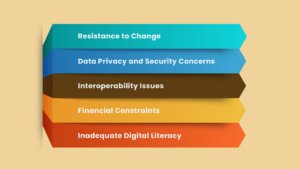
1. Resistance to Change
Healthcare professionals often feel apprehensive about adopting new technologies, fearing that it might disrupt established workflows and compromise patient safety.
2. Data Privacy and Security Concerns
With the increasing use of digital systems, there’s a greater risk of data breaches and privacy violations, leading to concerns among healthcare organizations and patients alike. To overcome this challenge, adopting blockchain technology is highly recommended. Blockchain, used in finance, can help prevent cybersecurity breaches, identify inaccuracies in health records, and allow secure access and sharing of patient data. Medicalchain is already using blockchain to address fragmented medical records.
3. Interoperability Issues
The lack of standardized systems and interoperability between different healthcare software and devices can hinder seamless data exchange, leading to fragmented patient information.
4. Financial Constraints
Digital transformation in healthcare needs a lot of money and partnering with a software company. This can be expensive, especially for small clinics with tight budgets. However, it can lead to higher growth, more profits, and increased revenue compared to traditional methods.
There are cost-saving ways to approach this transformation. One popular method is Agile Software Development. This approach makes the process faster and more flexible. It allows for easy and cost-effective changes by using a step-by-step model.
5. Inadequate Digital Literacy
Healthcare is facing labor shortages and a skills gap among both new and experienced professionals, especially those not trained in new digital tools. Hospitals need better training programs to help staff stay effective in the digital age. Important skills include digital transformation, project management, computer science, automation, and data analysis. Additional skills like AI and cybersecurity are becoming valuable. Despite fears, AI will not replace nurses but enhance their roles by ensuring accurate diagnostic predictions.
Strategies for Overcoming Resistance to Change
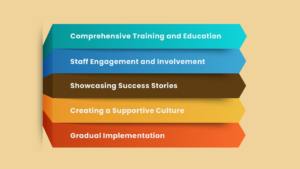
To successfully navigate the challenges posed by resistance to change, healthcare leaders ought to employ the following strategies.
1. Comprehensive Training and Education
Healthcare professionals ought to have access to continuous training and education to enable them to understand the scope of digital transformation and how best to leverage new healthcare technologies.
2. Staff Engagement and Involvement
Frontline healthcare staff are the ones who will use these technologies the most. Therefore, it makes sense to incorporate their opinions and insights as part of the decision making process before employing new healthcare technologies.
This will make the transition more inclusive and successful.
3. Showcasing Success Stories
Sharing success stories from other healthcare facilities that have successfully adopted digital solutions can serve as inspiration and motivation for hesitant professionals.
4. Creating a Supportive Culture
It is important to foster a culture that encourages innovation and continuous improvement. Recognize and reward individuals and teams for embracing digital tools and showcasing positive outcomes.
5. Gradual Implementation
Implement digital changes in phases rather than making sudden overhauls. This approach allows staff to adapt gradually and provides time for troubleshooting and fine-tuning.
6. Collaborating with the Right Technology Vendors
Collaborating with technology vendors and partners is crucial for the successful adoption of digital solutions in healthcare. Here are some key capabilities to look for before deciding on a healthcare technology vendor to partner with.
-
Needs Assessment
Work closely with vendors to conduct a comprehensive needs assessment to determine the most suitable digital solutions for the healthcare facility’s specific requirements.
-
Vendor Expertise
Choose vendors with experience and expertise in healthcare technology and a proven track record of successful implementations.
-
Data Security and Privacy Assurance
Prioritize vendors that prioritize data security and comply with relevant healthcare regulations to protect patient information.
-
Interoperability Solutions
Select vendors that offer interoperable systems to ensure seamless data exchange between different healthcare platforms.
-
Ongoing Support and Training
Ensure that the healthcare technology vendor provides ongoing support and training for healthcare professionals, even after the initial implementation, to address any challenges that may arise.
Revolutionize Your Healthcare Enterprise with CrossAsyst
Updating your legacy healthcare systems and workflows is no longer just innovation; it is a necessity. Aspects such as digitized health records, remote monitoring and online consultations have become commonplace.
And CrossAsyst is just the right partner to help you step into the future. Our HIPAA compliant team comes with more than a decade of expertise in developing EHR and other customized healthcare solutions.
Our team will work closely with you through every step of the development process. From taking time to build a detailed plan, developing your customized solutions and testing every aspect of the product to running pre-launch demonstrations and ensuring your team adapts to the new technology well after launch, you can rest easy knowing we’re invested in your new healthcare solution succeeding right from the get go.
Get in touch with us today, and let’s work together to build the technology that will power tomorrow’s healthcare.
The Covid-19 pandemic brought to light the important role of digital technologies in healthcare, ranging from EHR, remote monitoring and much more.
Here’s a detailed look at the digital transformation of healthcare, including key technologies driving healthcare in 2023, the benefits of this digital transformation, roadblocks, solutions and more.

